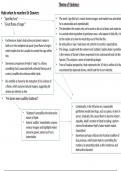Theme of Violence:
Hyde when he murders Sir Danvers:
• “Ape-like fury” • The simile ‘ape-like fury’ creates simian imagery and implies how animalistic
• “Great flame of anger” he is untameable and unpredictable.
• This bewilders the reader who are focused on his out of place and mysteriou
• In a period when reputation of gentlemen was a vital aspect of daily life, it is
• Furthermore, Hyde’s destructive and violent nature is to the reader as to how he would step out of line like this.
built on in the metaphorical quote ‘great flame of anger’, • By acting like an ‘ape’, Hyde does not conform to society’s expectations.
which implies that he is unable to control the rage within • This image, coupled with the violent verb ‘clubbed’, implies Hyde is primitive
him. is the reverse of Darwin’s theory expressed in his controversial book On the
Species. This conjures a sense of underlying danger.
• Stevenson comparison of Hyde’s ‘anger’ to a flame, • From a Freudian perspective, Hyde represents the ‘id’ that is within all of hum
something that is associated with violently flaring out of encumbered by depraved desires, which lead him to act violently.
control, amplifies the violence within Hyde.
• His volatility is shown by the metaphor of his violence of
a flame, which conjures natural imagery, suggesting his
actions are intrinsic to him.
• “His bones were audibly shattered”
• Contextually, in the Victorian era, respectable
• ‘Shattered’ exemplifies the destructive gentlemen would take drugs, such as opium, in dens in
nature of Hyde. secret. Gradually, this caused them to become violent .
• Adverb ‘audibly’ immediately conjures Arguably, Jekyll’s creation of Hyde by taking a potion
sensory imagery and highlights Hyde’s mirrors/foreshadows Hyde’s future violent nature.
immense power, almost as if he is (reputation)
indomitable. • Stevenson perhaps criticises the Victorian tradition of
drug overuse, which leads Hyde to committing the
murders, by presenting Hyde as this murderous and
destructive character.





